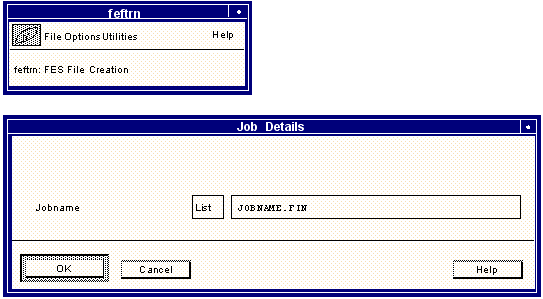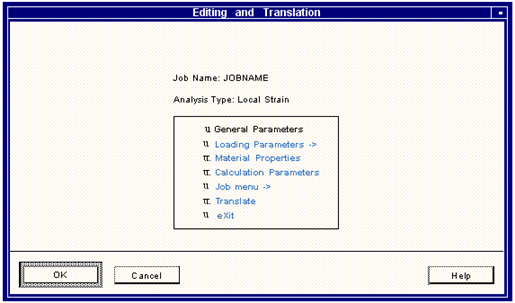XXXXXXXXXXXXXXXXXXXXXXXXXXXXXXXXXXXXXXXXXXXXXXXXXXXXXXXXXXXXXXXXXXXXXXXXXXXXXXXXXXXXXXXXXXXXXXXXXXXXXXXXXXXXXXXXXXXXXXXXXXXXXXXXXXXXXXXXXXXXXXXXXXXXXXXX''"> Other Modes of Job Setup
MSC Fatigue can be run in three different forms. The preferable manner is to run directly from within MSC Patran or MSC Fatigue Pre & Post where access to all the features of MSC Fatigue are available. However, another non-graphical mode of running MSC Fatigue is available.
MSC Fatigue requires three basic inputs for a successful analysis.
1. Cyclic material properties. MSC Fatigue provides a comprehensive materials database. This database is expandable allowing the user’s own defined properties. A database manager is provided for viewing, editing, adding and manipulating materials data. See
Material Management (Ch. 3) for detailed instructions.
2. Load information. MSC Fatigue also provides a time history database manager for managing, manipulating, adding and viewing time histories. It is necessary to define the load variation with time when using static stress results from finite element analyses. See
Loading Management (Ch. 4) for detailed instruction. When using transient stress results a separate time history definition is not necessary.
3. Stress or strain results. This information can be provided by translating external results files from finite element analyses directly within MSC Fatigue or by simply supplying the stress component at a single location manually. This last method is described in
Utilities. The direct method is described here in this section.
To set up an MSC Fatigue job in this non-graphical mode, follow these basic steps assuming that materials data are available and loading time histories are also available if necessary:
1. Run the MSC Fatigue module FEFAT to produce a simple fatigue input file with stresses at a single location (see
Utilities), or run the MSC Fatigue module FEFTRN to translate finite element results into a MSC Fatigue input file. To run any of these modules at the system prompt simply type
fefat or
feftrn respectively. By either one of these methods you will end up with a MSC Fatigue input file called
jobname.fes. FEFTRN operation is explained below.
2. Next run the MSC Fatigue module FEFAT to preprocess and run the actual fatigue analysis. The operation of this module is explained thoroughly in
Total Life and Crack Initiation (Ch. 5). For Crack Growth analyses, do the same thing but with the crack growth analyzer called PCRACK which is described in detail in
Crack Growth (Ch. 7).
3. For Total Life and Crack Initiation analyses, a results file will be produced which can be postprocessed by commercial postprocessing systems.
FEFTRN
This section documents the operation of FEFTRN, an MSC Fatigue module used to translate results from either an MSC Nastran results database (the .xdb file) or from a Universal file. To invoke the program simply type feftrn at the system prompt.
Figure 2‑3 FEFTRN Utility Form
You will be presented with the above forms which first asks you for a jobname with a .fin file extension. You may select an existing one or create a new one. The .
fin extension is not necessary to specify and will be added if not specified. The
jobname.fin file is an ASCII fatigue job parameter file which is fully described in
The Job Information File (jobname.fin).
If an existing job file is selected the following main menu is displayed:
If a new job is specified, then you are led through a number of pages that ask you to set various parameters. Only one of these parameters is described in this section: FE Results Source. The other parameters are fully described in various sections in this chapter. General and Calculation Parameters are described in
General Setup Parameters, Loading Parameters in
Loading Information Form, and Material Properties in
Materials Information Form. Not all parameters are valid at all times. If a parameter is dimmed then it is not valid or necessary for the configuration that you currently have set up.
Once all parameters have been set properly you may press the Translate toggle to create a jobname.fes file for input to an MSC Fatigue analysis using FEFAT.
The only parameter that is not described elsewhere is the FE Results Source. You may read results from two sources: an .xdb file created by MSC Nastran with the PARAM, POST, 0 parameter in the input file, and from a SDRC Universal file. Simply set the FE Results Source to either MSC Nastran or SDRC Universal in the General Setup and then under General Loading specify the file name.
The MSC Nastran reader supports stress results at grid points (requested with a GPSTRESS case control card) and element centroidal stresses (requested with a STRESS case control card) for shell and solid elements for both static and transient analyses.
The Universal file reader only supports static analyses for stress and strain results. The Universal file must have stresses or strains on either nodes or elements only. Node at element is not supported. Supported datasets are 55, 56, and 2414. Also note that the Universal file format supported in from the older version of SDRC’s IDEAS, not the new MasterSeries version. This type can only be imported using MSC Fatigue Pre & Post. See
Import FE Model/Results.
To create fatigue results in Universal file format as opposed to the standard MSC Patran results file format, set the keyword FEFTYPE to the value UNIVERSAL using the MSC Fatigue environment module NENM See
Modifying the MSC.Fatigue Environment (MENM).
In both MSC Nastran and Universal file translations, all elements found for the defined load cases will be processed using the same group attributes, e.g. material, surface finish, Kt, etc. Multiple materials, surface finish and such are not supported.


